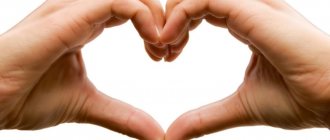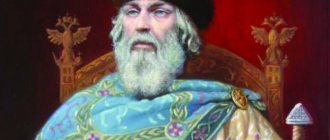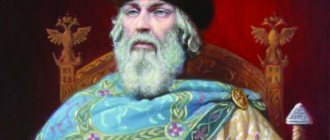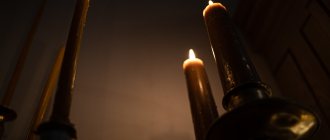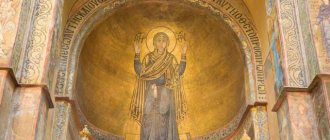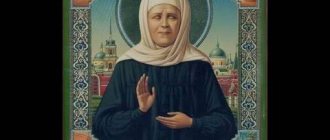The Cathedral of Notre-Dame de Paris (Notre-Dame) houses the Crown of Thorns of Jesus Christ - a thorn with sharp thorns was placed on the head of the Savior, aggravating His torment.
The image of Jesus Christ with a crown of thorns is an image of suffering, because the crown was a “buffoonish” coronation and was an instrument of torture. But it is also a subject of reverence and hope. You will find out why in this article.
Historical excursion[edit]
Three evangelists write about the placing of a crown of thorns on Jesus Christ: and having woven a crown of thorns, they placed it on His head and put a reed in His right hand; and, kneeling before Him, they mocked Him, saying: Hail, King of the Jews!
(Matt. 27:29)
and they clothed Him in scarlet, and having woven a crown of thorns, they placed it on Him
(Mark 15:17)
And the soldiers, having woven a crown of thorns, put it on His head, and clothed Him in scarlet
(Jn. 19:2)
Christ in the Crown of Thorns
It is not written in the canonical Gospels about when the crown of thorns was removed. Some artists paint Jesus Christ on the cross with a crown of thorns.
Until the 10th century, the Crown of Thorns of Christ, according to church tradition, was kept in Jerusalem, in the 10th century it was transferred to Constantinople, in 1204 the Crusaders captured Constantinople and took the shrine to Europe. In 1238, King Louis, a saint of the Catholic Church (1214-1270), solemnly welcomed the Lord's Crown of Thorns 40 km from Paris. According to the chronicler, Louis took off all the royal regalia and shoes and carried the Crown on his shoulders. To store the shrine, the Holy Chapel (Sainte Chapelle) was built on the Ile de la Cité.
During the French Revolution, the Chapel burned, and the shrine was moved to the National Library. The Church turned to Napoleon with a request for the return of the shrine, Napoleon returned the Crown of Thorns to the Church and even presented it with a gift of a reliquary to store the Crown (all this despite his personal atheistic inclination). In 1806, the Crown of Thorns, sealed in a special glass capsule, was placed in the sacristy of the Cathedral of Notre Dame de Paris, where it is kept today.
Until recently, the Crown of Thorns of Christ was brought out for worship by believers only once a year. Timothy Katnis, historian, head of the Pilgrimage Center of the Apostle Thomas in Europe: “Keeping a shrine under cover or in the treasury of temples is a long-standing tradition of Western Christians. This was also due to the fact that the shrine was hidden for fear of being stolen during times of war and unrest. Many people know that, for example, the relics of St. Nicholas of Myra in Bari lie hidden and are not opened to pilgrims.
However, several years ago, the Catholic Church met the Orthodox halfway, in whose tradition the shrines are kept open for worship. After all, the Savior’s Crown of Thorns is a common Christian shrine. Therefore, an agreement was reached between the Bishop of Paris, Jerome Boys, and the Bishop of Korsun, Innocent (Vasiliev), according to which the Savior’s Crown of Thorns, together with a particle of the Cross and the Nail from it, will be taken out for the veneration of believers once a month.”
Savior in the crown of thorns: icon
The icon of the Savior with the crown of thorns came to Orthodox culture from the Catholic Church, where this image was very popular and began to spread in the 13th century, immediately after the purchase by Louis IX. In Russian iconography, the image appears after the reforms of Peter I and intensifies in the 19th century. The emotional portrait of Christ wearing a crown, “Behold the Man,” painted by Guido Reni in the 17th century, is popular among Christians. It depicts Christ with his head raised, slightly tilted, and his eyes rolled back. The image conveys the moment of physical pain, bodily suffering of the Savior.
The crown of thorns of Jesus Christ reminds us every time of how we can help ourselves to be more forgiving towards other people. After all, one has only to think about the depth of what the Savior experienced and the meaning of all this suffering, and it becomes obvious that Christianity cannot be invented. It just can't be made up. The innocent took upon himself all the wounds of the world to atone for the guilty. The sinless one came to earth to redeem from sin and death. The entire modern culture, the values we know, the concept of freedom, human dignity - everything that is dear to a modern progressive person - all this was born from Christianity. How often do we remember this?
Location. Accessibility for pilgrims[edit]
Notre Dame Cathedral
Address:
Paris, 6 pl.
du Parvis Notre-Dame, metro Cite. Opening hours:
from 8.00 to 18.45 from Monday to Friday, 08.00 to 19.45 on Saturday and Sunday.
The crown is not available for worship every day. It, along with a particle of the Cross of the Lord and the Nail from the Cross, is taken out for veneration on the first Friday of every month, at 15.00 - the hour when Christ died on the Cross, as well as on Good Friday of the Catholic Lent. This service is called the Rite of Adoration of the Crown
. A procession emerges from the sacristy - knights, ladies in black and the guardians of the Crown, along with Catholic priests. A crown in a crystal case, a piece of the Holy Cross and a crucifixion nail are carried through the temple and solemnly placed on the throne. The Gospels of the Passion of the Lord are read, then the veneration of the Crown begins. It is customary to bow before the Crown (Orthodox people bow to the ground), and you can venerate.
On other days there is no access to these shrines. It is necessary to pay attention to the fact that the dates of Lent for Catholics and Orthodox Christians often do not coincide. Since there are a lot of people interested, it is better to get in line in advance, before the ceremony starts at 15.00.
Description
The crown is a wreath woven from strong branches of a thorny plant, to which are added jujube stems. This shrub has many long, sharp thorns. It is believed that the Crown of Thorns originally contained about 70 thorns, which over time were transferred to various Christian churches.
The chronicles contain evidence of the flowering of the relic dating back to the beginning of the 13th century. Currently, the wreath is stored in a sealed crystal case. The places where the shrine was cut are hidden with gold braces.
Holy Grail
The Holy Grail, like the Shroud of Turin, is not recognized as an official relic. The main contender for the role of the vessel that was used during the Last Supper is a cup kept in the cathedral in Valencia. For ordinary people, like Jesus and the apostles, the vessel is too rich, but according to research, the glass part of the vessel is actually about 2000 years old and comes from the Middle East, from Phenicia.
Who are the apostles?
In the work of his public ministry, Jesus chose disciples. They are called holy apostles. Christ explained the doctrine of God to the apostles and revealed the truths of Christianity. The apostles were with Christ during his miracles, as well as at the main and most important moments of his life. Sometimes Christ took three disciples with him as witnesses to his great miracles. For example, Peter, James and John witnessed the transfiguration of Jesus Christ and the resurrection of the daughter of Jairus. Among the apostles there are 12 and 70 people. The first to be called to the apostleship were Andrew the First-Called, Peter, John, James Zebedee, Matthew, Philip, Bartholomew, Simon the Zealot, Thomas, James Alphaeus, Thaddeus, and Matthias. They are called apostles from the 12. Later, 70 more apostles were chosen by Christ. Apostles, that is, “envoys, ambassadors”; their task was to absolve man from sins, to baptize nations in the name of the Father and the Son and the Holy Spirit.
Mandylion
Genoese:
Vatican:
The Mandylion, or the Savior Not Made by Hands, is the Eastern Christian analogue of the Plath of Saint Veronica. According to legend, it was made by Jesus himself, when he was still free and in good health, in response to the request of the ruler of the city of Edessa to send his image.
Available in 2 versions. The first is kept in Genoa, in the Armenian Church of St. Bartholomew. The other is now kept in the Vatican Palace, in the Chapel of St. Matilda.
God's foreskin
Jesus was born into a normal Jewish family and went through all the rituals required in Judaism, including circumcision. In theory, the only visible part of the Lord's body should have become one of the main shrines. But her Jewish origin, as well as the place from which the flesh of the Lord was taken, caused something like modesty. Perhaps this is why doubts about its authenticity arose already in the early Middle Ages. There was a fairly widespread opinion that at the moment of Christ’s ascension to heaven, all parts of his body, such as nails, hair, etc., including, of course, the foreskin, should also have ascended to heaven. In addition, there were several foreskins, the most famous of which were in the Abbey of Charroux in France and in the town of Calcata in Italy. At the same time, there was a persistent opinion that it was not without reason that the New Year was set on January 1, the date of Jesus’ circumcision.
Ultimately, in 1960, Pope John 23 decreed that any mention of the foreskin would be punishable by excommunication, and January 1 became simply the eighth (liturgical octave) from Christmas.
Shroud of Turin
Unlike most of the other listed items, the Shroud of Turin, oddly enough, is not officially considered a relic (that is, an object with sacred status and the ability to perform miracles). That is why it is one of the most studied subjects of this kind. The church allows scientists to study real relics with much greater difficulty. However, the church, of course, does not prevent its demonstration and worship.
Skeptics like me consider the Shroud to be more likely a fake. However, neither the time of production, nor the author, nor the method could be indicated. The shroud has no analogues and, judging by pollen analyses, the fabric actually originates from the Middle East. Since the time of creation is indicated as the 12th-13th century, the image was most likely created in Europe, since the Middle East was already Islamic.
There is a unique illustration in the Bible written in the 11th century in Serbia, which can be interpreted as an image of the Shroud (due to the characteristic L-shaped arrangement of holes in the fabric).
4. Sudarion
Sudarion is something like a towel (size 80x50cm, more like a bath towel), covered with blood stains. It has been kept in the cathedral in Oviedo since the 7th century. The word itself means “to wipe away sweat.” According to legend, it covered the bleeding head of Christ. Which, obviously, did not prevent the image from appearing on the Shroud of Turin, which, according to another legend, was a funeral shroud and covered the entire body.
Another piece of fabric, soaked in the blood of Christ, is kept in Bruges, where it ended up after the 2nd Crusade.
Holy Cross Nails
Oddly enough, it is not known exactly how many nails were used in the crucifixion. In the traditional image of the crucifixion, there are 3 nails. But the only find today of an incomplete skeleton of a crucified person points more likely to 4 (Moreover, the legs were nailed not from the front, but from the side).
Be that as it may, at the moment about 30 real nails are known with which Christ was once nailed to the cross. Here you need to add a certain amount that was forged into other items. For example, the so-called Lombard crown is strengthened with an iron ring forged from one of the nails.
The fact that there are more relics than expected by common sense is a well-known phenomenon dating back to the early times of Christianity. The classic explanation for this is the ability of relics to miraculously reproduce. The Lord, in his inexplicable mercy, allows relics to exist in many copies, all of which are recognized as real, in order to shower their grace on as many believers as possible.


